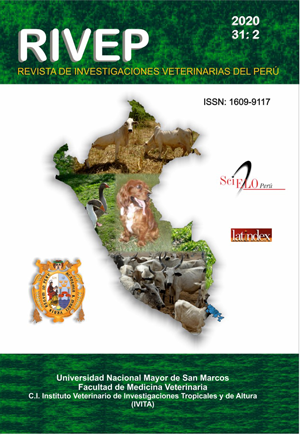Anti-Listeria activity of Enterococcus spp isolated from garden snail (Helix aspersa Müller)
DOI:
https://doi.org/10.15381/rivep.v31i2.16617Keywords:
Mollusca, bacteriocinogenic enterococci, ListeriaAbstract
In this study, the antimicrobial activity of Enterococcus strains isolated from the gut content of garden snail (Helix aspersa Müller) was investigated by agar diffusion assay. Among the 90 isolates obtained, 37 exhibited inhibitory activity against one or more of the Listeria strains tested. Based on the highest activity, 16 enterococci strains were selected for further studies. None of these strains exhibited β-hemolysis or gelatinase activity and all were sensitive to vancomycin. Treatment with lysozyme and catalase did not affect the anti-Listeria activity. Moreover, the enzymatic activity of trypsin abolished the inhibitory action of the cell-free supernatants (CFS), confirming the protein nature of the active compounds. In all cases CFS activity remained stable after heat treatment (100 ºC, 10 min). These characteristics described agree with bacteriocin type II of lactic acid bacteria. Among the 16 selected isolates, biochemical test allowed the identification of nine E. avium strains, five of E. mundtii and two of E. faecium. The highest activity was observed in E. mundtii strains with values between 163 840 to 327 680 arbitrary units/ml (UA/ml). These results suggested that garden snails could be a suitable source for the isolation of bacteriocinogenic Enterococcus strains with potential technological applications, food biopreservation or probiotics.
Downloads
Downloads
Published
Issue
Section
License
Copyright (c) 2020 Romina Parada, Débora L. Andoro, Emilio R. Marguet, Marisol Vallejo

This work is licensed under a Creative Commons Attribution-NonCommercial-ShareAlike 4.0 International License.
AUTHORS RETAIN THEIR RIGHTS:
a. Authors retain their trade mark rights and patent, and also on any process or procedure described in the article.
b. Authors retain their right to share, copy, distribute, perform and publicly communicate their article (eg, to place their article in an institutional repository or publish it in a book), with an acknowledgment of its initial publication in the Revista de Investigaciones Veterinarias del Perú (RIVEP).
c. Authors retain theirs right to make a subsequent publication of their work, to use the article or any part thereof (eg a compilation of his papers, lecture notes, thesis, or a book), always indicating the source of publication (the originator of the work, journal, volume, number and date).



